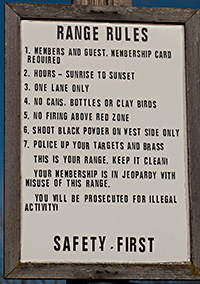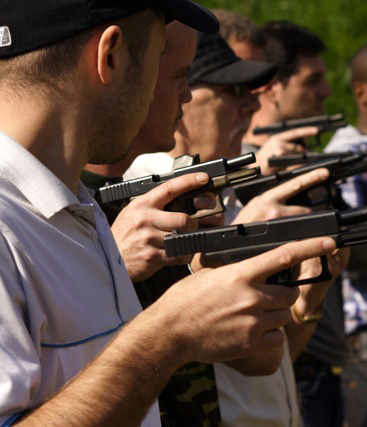Club Gun Safety Rules
Club General Range Rules
1. Each Member and family member are required to have completed a range safety class before being allowed use of the range.
2. F.O.I.D. card must be with you at all times while on Club’s range property. 3. Each member using the range must display a membership card on the clip at the front gate. If a card is displayed on the clip, the newly arriving member(s) will place their cards behind all cards currently attached to the clip. The member whose card is displayed in the outermost position on the clip has control of the range, and will remain in control until that member removes their card. 4. Any membership card found on the clip, or grounds, with the owner not present shall be placed inside the clubhouse where it will be returned to the member who lost it. 5. Any vandalism or defacing of club property will be grounds for revocation of membership. 6. It is the responsibility of a member who witnesses and unsafe act, or direct violation of the range rules, to advise the violating member or guest to correct the problem. If the violating member does not correct the problem, the board must be notified with the following information if possible: member’s name, vehicle make, license number, date and time of violation, and the violation witnessed. This notification can be either by filling out a violation report or by contacting an officer or director in person, or by e-mail. 7. The use of unsafe firearms or unsafe ammunition is prohibited. Example of this are: firearms which discharge more than one round with one pull of the trigger, weapons that have been modified in and unsafe manner, or ammunition which is visibly damaged or repeatedly misfires or hang fires. 8. No discharge of firearms is to occur prior to 9:00 a.m. on weekends and holidays. On all other days, firearms must not be discharged earlier than one hour after sunrise. Cease-fire will be called one hour prior to sunset on all days. 9. Weapons with large caliber/ high velocity rounds fired from them will need to be approved by the board for use on the range before they can be discharged (.50 bmg, 45/120, 45/90, etc. are all examples of such rounds). 10. No fully automatic or Class III firearms may be fired on the Club’s range. 11. Firearms may be loaded only while on the “firing line” and only when a” safe range condition” has been observed. A safe range condition is defined as: nothing but targets down range, and all shooters in agreement that it is safe to load their firearms. 12. A firing line will be determined by the member who has control of the range. This firing line is the only distance that a round may be fired from on that range. Do not fire a round from any other distance on that range without a new firing line being established. 13. While on club grounds, unless cased or holstered, all firearms shall be unloaded. The term unloaded is defined as: the actions of all pistols, rifles, and shotguns, the cylinders of all revolvers, and the gates of single action firearms shall be “open” with all magazines and/or clips removed. The only exception to this rule is for law enforcement agents visiting the club. 14.Before going forward of any firing line a “cease fire” situation must be established. A cease fire situation is defined by the following: all firearms must be confirmed as “clear”, or unloaded by each person on the firing line announcing “I am clear”. When all people on the firing line have been confirmed clear, someone must announce “the line is clear” before a cease fire can be confirmed. 15. When an emergency “cease fire” is called, all shooters must quit shooting, unload their firearms and leave them in an open position on the shooting bench. 16.The touching or handling of firearms, ammunition or magazines while others are down range is strictly prohibited. All people present must remain at least 3 feet back of the firing line when anyone is down range. 17. No firearm, unless unloaded and holstered, may be carried to the target area for any reason. 18. No tracer rounds or armor piercing and steel core ammunition are permitted on Club property. 19. No rapid fire is allowed on any range. Sustained fire is acceptable. Sustained fire is defined as: when one’s ability allows that all shots are on target at the speed they are shooting. 20. Aerial targets are strictly prohibited. 21. Only board approved targets may be fired at. Firing at unapproved targets is strictly prohibited. Targets which are unapproved are: metal targets, bowling pins, explosive targets, glass, and any target which extends above the top of the berm. 22. The use of the “splatter board” targets are for official club shoots only. 23. Digging in any backstop is prohibited. 24. Members are responsible for policing any range area they or their guest(s) use. All refuse, including targets, paper, cardboard, wood, and spent shell casings must be deposited in proper receptacles, or removed from club grounds. 25. There is to be absolutely no hunting or intentional firing at any animals or birds on Club property without approval from the board of directors/officers. 26. If in doubt of any rule or regulation, it is the member’s responsibility to make certain that he or she, as well as his or her guest, is not in violation of any and all Club range procedures. 27. Any member and/or guest who sustains any kind of bodily injury due to the discharge of any firearm while on Club property, shall notify either a Club Officer or Board of Directors. 28. Any procedures, special requests or variation of these range rules, which may or may not be covered, must be brought to the attention of the Board of Directors and/or Officers for consideration. 29. Refusal to identify oneself or one’s guest will be cause for any person to be asked to vacate the Club’s property. 30. Penalties for violations of any of the Club rules shall vary from a warning to possible expulsion. |
NRA Gun Safety Rules 1. ALWAYS keep the gun pointed in a safe direction.
This is the primary rule of gun safety. A safe direction means that the gun is pointed so that even if it were to go off it would not cause injury or damage. The key to this rule is to control where the muzzle or front end of the barrel is pointed at all times. Common sense dictates the safest direction, depending on different circumstances. 2. ALWAYS keep your finger off the trigger until ready to shoot. When holding a gun, rest your finger on the trigger guard or along the side of the gun. Until you are actually ready to fire, do not touch the trigger. 3. ALWAYS keep the gun unloaded until ready to use. Whenever you pick up a gun, immediately engage the safety device if possible, and, if the gun has a magazine, remove it before opening the action and looking into the chamber(s) which should be clear of ammunition. If you do not know how to open the action or inspect the chamber(s), leave the gun alone and get help from someone who does. When using or storing a gun, always follow these NRA rules:
|


